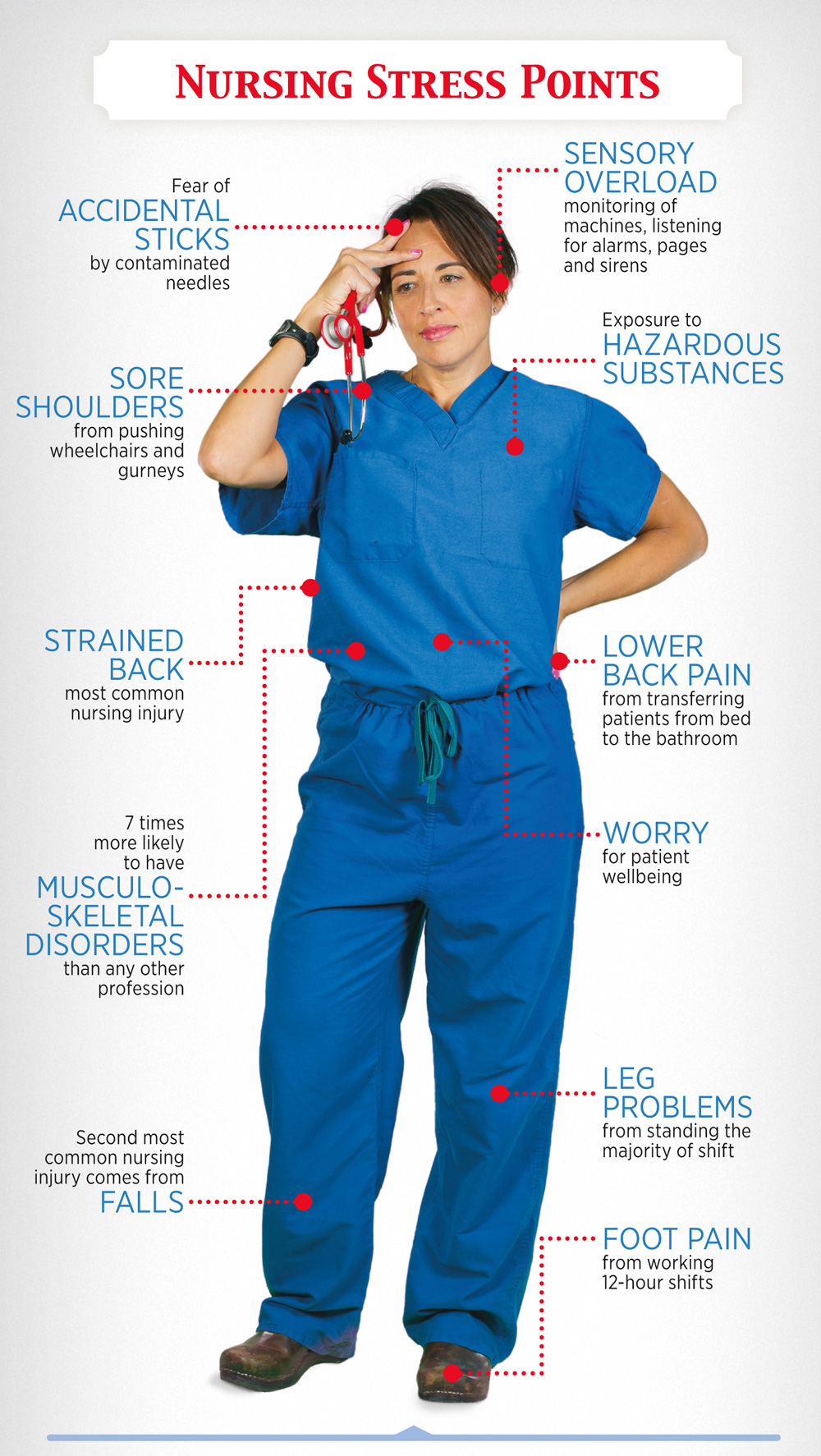
Ashley Byrd, B.S.N., RN, became interested in mental health nursing while earning her bachelor’s degree.
“I noticed that there was a shortage of nurses in this field and I wanted to help make a difference,” she said. “There is still such a stigma attached to mental health issues, but these are our mothers, fathers, brothers and sisters. Who knows when we might be stressed because of what happens in life or depressed because of a traumatic event? I want to be there for my patients, to help them and guide them.”
Working in the mental health field for three years, Byrd couldn’t help but notice that nurses also suffer from stress while caring for patients, regardless of the area in the hospital where they work.
“There are a lot of things in the hospital culture that can cause stress. In my field, acutely ill psychiatric patients can cause nurses stress,” she said.
Other common examples of stress in the nursing workforce include not having the right supplies, frequent interruptions while preparing patient medications, long or varying shifts, demanding workloads, and having fewer nurses than are needed on a shift. Physical manifestations of this stress include a higher risk of infection because of compromised immune systems and frequent exposure to ill patients. Stress in the nursing workforce is also associated with other occupational hazards such as neck, shoulder and lower-back injuries from lifting and positioning patients, and foot and leg problems from being constantly on their feet.
“Stress actually is an epidemic in nursing. It’s a psychological problem and a physiological problem. And in the end, it can affect the quality of patient care,” said Byrd, who is seeking a master’s degree and certification as a psychiatric mental health nurse practitioner in the School of Nursing.
Stress often leads to absenteeism, burnout, and for some nurses, leaving the profession, she added.
Through her master’s coursework, Byrd was introduced to evidence-based quality improvement—how to use and conduct research to improve the quality of care for patients. Because of her background, it was a natural fit for Byrd to become a research assistant on a study conducted by Frank Puga, Ph.D., that examines the psychological and physical factors of stress.
“From the national perspective, there is an awareness of stress in the nursing workforce, but there have been few systematic investigations that quantitatively measure the causes and effects of stress, and what we can do to improve the nursing work environment from a systems approach,” said Dr. Puga, an assistant research professor in the Center for Advancing Clinical Excellence (ACE), a center of excellence in the School of Nursing.
This is a critical issue, he said. There is increasing evidence that unhealthy work environments can contribute to stress among health professionals as well as medical errors and ineffective delivery of care, according to the American Association of Critical Care Nurses, which is leading a national initiative to encourage healthier nursing work environments. Improvements are essential for patient safety, the association found, and could enhance staff recruitment and retention.
Dr. Puga and Byrd are studying stress with nurses from San Antonio’s Methodist Hospital. They will be collecting saliva samples to measure cortisol, a physiological biomarker of stress. Nurses also will fill out surveys and routinely document the stressors in their work environment, such as disruptions in workflow processes and problems with teamwork. Data will be collected on organizational culture, job satisfaction and turnover rates to better understand the relationship between system variables, stress and staffing outcomes.
Wanda Gibbons, RN, B.S.N., M.H.A., NEA-BC-FACHE, chief nursing officer at Methodist Hospital and interim chief nurse executive for Methodist Healthcare, said stress in frontline nurses is an important research topic that hospital officials were eager to help explore.
“Most of our research on stress has been qualitative,” she said. “This study will give us the opportunity to collect direct, quantitative data to provide a better environment for our nurses. It will help our nurses become more aware of how they deal with stress and will help advance nursing research.”
This pilot study is funded by a $10,000 research grant from the American Organization of Nurse Executives, which promotes leadership, professional development, advocacy and research to advance nursing practice and patient care.
Once the process for data collection is refined in the pilot study, Dr. Puga plans to conduct a full-scale national study on this topic through the Improvement Science Research Network (ISRN), a national, interprofessional research network based in the ACE.
“The ISRN helps establish best practices by taking studies that have been proven to work in one or a few hospitals and conducting them across the country at many different sites,” explained Kathleen Stevens, Ed.D., RN, ANEF, FAAN, director of the ACE and ISRN. “When a new idea is proven to work well in many environments, it can become a new model of improved care, reflecting best practices.”
Byrd, who will collect saliva samples from nurses and communicate frequently with them about the study, said she’s excited to be working with Dr. Puga to investigate a major issue that plays a part in clinical excellence.
“And as a future mental health nurse practitioner,” she said, “I am looking forward to consulting the literature and conducting evidence-based practice to help my patients and contribute to the body of knowledge for health professionals.”
